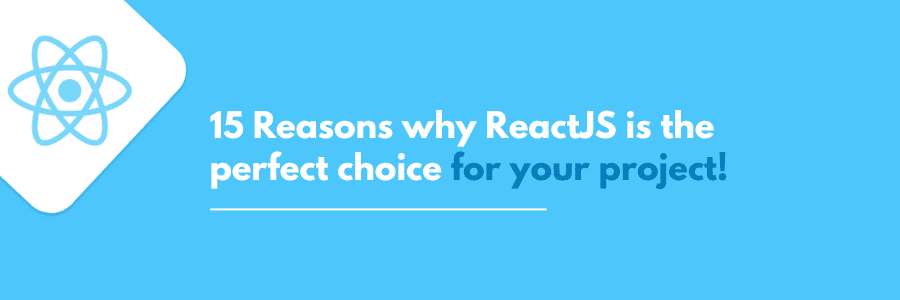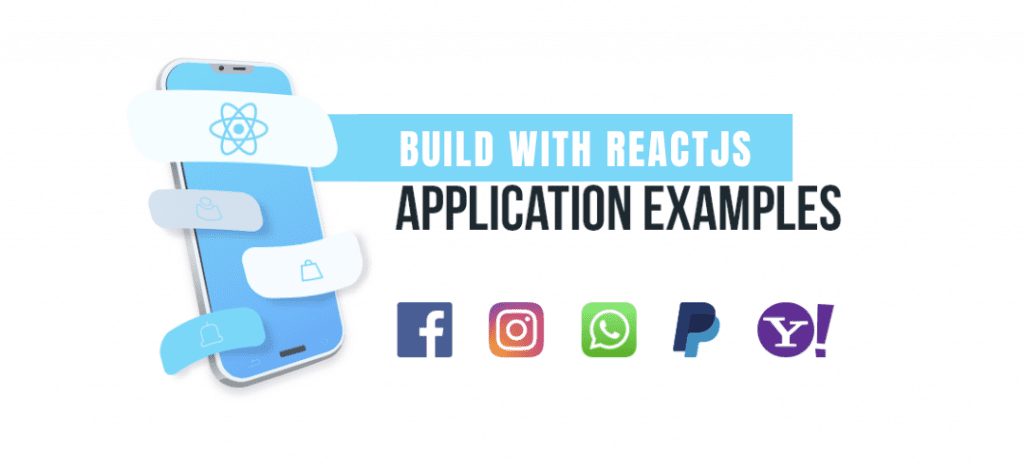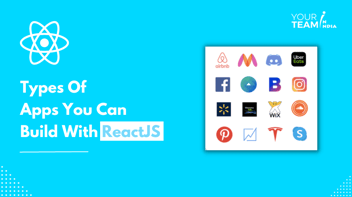Quick Summary: ReactJS is a popular JavaScript library for building user interfaces, with many advantages for application development. Its component-based architecture, virtual DOM, and efficient rendering make it a powerful tool for creating fast, responsive, and reusable UI components. In this article, we will explore 15 advantages of ReactJS for application development.
Let's admit it.
In today's fast-paced digital world, staying ahead of the competition requires more than just a functional application.
It demands scalability, speed, and seamless user experiences.
And that is where React JS shines!
React Js is a user-friendly, strong, and flexible open-source JavaScript framework that can create quick, single-page applications and versatile front-end development programs. Additionally, the React JS library is a JavaScript toolkit that helps developers create attractive user interfaces more easily.
Trusted by top industry giants, React JS is a powerful solution for creating cutting-edge applications that deliver exceptional business results.
In this blog, we will explore the top advantages of using React JS and why businesses and developers are turning to this technology.
Whether you are looking to enhance your digital presence or want to boost your user engagement, hiring top-tier React developers can be a game-changer to meet your unique business requirements.
Key Takeaways
- ReactJS is a powerful JavaScript library for building user interfaces that offer many advantages for application development.
- Its component-based architecture and virtual DOM make it easy to create reusable UI components and optimize performance.
- ReactJS provides excellent developer tools and a large and active community, which makes it a popular choice for front-end development.
- By using ReactJS, developers can create faster, more responsive, and more maintainable applications, which can lead to improved user experiences and business outcomes.
Why ReactJS is so Popular?
React.js is popular because of its component-based architecture, which makes code easier to reuse and scale. Its Virtual DOM improves performance, making updates more efficient.
According to Statista, React is widely used among developers and is the second most popular web framework, with 39.5% of developers using it.
Additionally, there are around 59,370,128 live react-based websites, with some significant giants like Canva, ChatGPT, Apple, Netflix, and Paypal using the technology.
Its ease of learning and ability to work across different platforms contribute to its widespread use. Not only the words but the numbers also prove its popularity.
Let’s check out some stats that showcase the popularity of Reactjs:
- React is an open-source tool with 226k GitHub stars and 46.1K GitHub forks.
- It is the 2nd most popular in India in the JavaScript Library category, as shown in the graph below:
- 2nd most popular in the Top 1 Million sites in the JavaScript Library category.
- 11896 companies reportedly use React in their tech stacks, including Uber, Google, and Facebook.
Discover the amazing advantages of incorporating React JS into your upcoming project in the section below!
Top 15 Advantages of ReactJs for your next project?

From simplified scripting to a quick rendering process and the ability to build SEO-friendly websites, ReactJS brings a myriad of benefits to developers and businesses.
It also allows the developers to include a search bar, integrated infographics, a calculator, interactive forms, and buttons, but that’s only the tip of the iceberg when it comes to the benefits of using React js. Below are some other reasons why both developers and end-users adore React.Js:
1. Declarative Programming
ReactJS uses a declarative programming style that specifies what should be on the visual aspects rather than prescribing completely complex logic. This is one of the key advantages that lead to its increased development speed and clean code development.
For instance, if a programmer manually updates the DOM (Document Object Model) with authoritative JavaScript, data changes may occur anytime. Also, DOM manipulation and verbose logic are required to sync the application state with the visuals.
On the contrary, the declarative style of React JS enables the developers to mention UI as a function of the data state. Therefore, whenever the modifications to the state occur, the UI automatically re-renders them, devoid of any need for manual DOM updates.
2. Component-based architecture
The component-based architecture of ReactJS enables the developers to create complex user interfaces by breaking them into smaller units known as "reusable components." This enhances the scalability and maintainability of the applications.
React components, as shown in the image above, can be used for a wide range of UI elements, from buttons and menus to comments and blog posts. By adopting this component mindset, developers can easily reuse and share these versatile bits of UI code across their apps. So, instead of repeating the same elements over and over, components help describe an element once and then reuse it everywhere.
By developing small and independent components, developers can also easily manage the different parts of a web app.
These independent components even have their own states. That means if the changes are done in one component, it won't affect the other components unless it is designed to do so.
3. One-way data binding
In a two-way data binding model, the UI libraries monitor changes in the data model and update the relevant DOM accordingly. This approach makes working with UIs complicated and confusing.
React, on the other hand, employs one-way data binding, as shown in the image above, ensuring that modifications made to child components have no impact on their parents.
It allows the developers to maintain a clear separation between the user interface and the data model. This simplifies the process and improves the overall performance of the applications.
4. Versatile integration with other libraries and frameworks
React is flexible and can easily work with many other libraries and frameworks. This means that developers have many options when it comes to choosing tools for their projects.
Whether they need to manage the state with a library like Redux or use utility libraries like Lodash, React can handle it. This makes React a great choice for projects that require different functionalities.
5. It comes with JSX
React JS includes an extended feature called JSX, which is used to create components for the application. JSX simplifies and streamlines code for large enterprise-level solutions that make it easier to manage and maintain.
JSX is a JavaScript extension that lets developers use HTML-style code to add dynamic content to the layout and template design of a webpage.
JSX makes it easier to write HTML markup. Its shortcuts help simplify and clean up your code, converting your HTML mockups into ReactElement trees. It also helps make the code more robust by displaying more errors, exceptions, and warning messages during the initial phases to ensure a high-quality product outcome.
Additionally, it provides developers with better insight into the workings of the user interface within the JavaScript code.
6. Simple learning curve
The simple learning curve of ReactJS is a significant advantage for both developers and businesses, providing a sense of security and equipping them with the necessary tools for success.
ReactJS allows developers to design user interfaces the way they want with less coding. This simplifies the code development, making it easier to understand compared to the complex coding required in imperative programming. This means that even developers with basic knowledge can work on it. Businesses can easily hire developers with the necessary knowledge and expertise.
7. Predictable data handling
Enforcing a one-way data flow in React makes it easier to understand how data changes and flows through the application. This helps create more predictable and bug-resistant code.
React also encourages using immutable data structures, where the state of an object cannot be changed after it's created. This immutability ensures updates are predictable. This makes it easier to understand how changes spread through an application.
By avoiding direct manipulation of data, React makes code easier to maintain, reduces bugs caused by unintended side effects, and simplifies debugging.
8. Improved developers productivity
ReactJS introduces a unique feature called 'Hot Reload,' enabling developers to update their apps in real time. This feature allows developers to instantly see the effects of their code modifications without the need for a full page refresh. The rapid feedback loop it creates accelerates the development cycle, empowering developers to iterate on their code and experiment with different approaches quickly.
9. Fast Rendering
Every business wants to handle large amounts of user data and update applications at the same time. React JS has a built-in feature called virtual DOM, which speeds up the rendering process and improves the overall user experience.
It also makes the application lightweight, resulting in better performance and productivity. Developers can use React JS to create advanced applications without having to worry about state transitions, which shortens the development timeline.
Additionally, Virtual DOM's in-memory tree representation of real DOM accelerates the process between the call and display functions.
10. Redux facility
Redux simplifies the storage and management of different states in large and complex React JS applications. It allows elements to access various transition states without creating bottlenecks, interacting with the child module, and using a callback. Additionally, it makes code testing simpler and improves server rendering.
11. Strong community and ecosystem

ReactJS benefits from a large and active community. This means developers have access to many resources, libraries, and tools. The community helps developers build applications faster by providing pre-built components and solutions for common challenges, saving time and effort. Additionally, it has a wide range of helpful tools, such as React libraries, testing frameworks, and components that streamline development.
12. Server-side rendering
With server-side rendering (SSR), the initial rendering of website pages takes place on the server rather than the client's browser. This offers varied benefits for web development.
In this, the server sends a fully rendered HTML page to the client. This allows the users to see the content quickly. By reducing this initial loading time, the SSR improves the website performance. This ultimately leads to increased user engagement and better user experience.
13. SEO friendly
Server-side rendering significantly boosts the search engine optimization for React app development. By rendering web pages on the server, search engines can crawl and index the content more effectively. This leads to enhanced website visibility in SERPs and a subsequent increase in organic traffic, making your website more visible and accessible to potential users.
The SSR also allows better social media sharing. Each time the server renders a page, it equips the metadata and 'Open Graph Tags' with the appropriate content. This ensures that when a website is shared on a social media platform, the shared content appears appealing and accurate.
14. Performance optimization
React.js is super smart – it updates using a virtual DOM and only shows the stuff that needs to be shown. This means your app runs faster and feels smoother because it doesn't waste time re-showing things you've already seen.
Additionally, with React.js, developers can make sure their code only loads when it's absolutely necessary, cutting down on wait time and making the whole app more quick and satisfying to use.
15. Accessibility
ReactJS is built with accessibility in mind. This makes it easier for developers to create applications that are accessible to all users. The component-based approach of React allows developers to build user interfaces that are accessible by reusing accessible components throughout the application. This ensures consistency and reduces the chances of introducing accessibility issues as the application grows.
Developers can also enhance the accessibility of their React applications by using ARIA attributes and semantic HTML elements within their components. By following React best practices, applications can be made accessible to screen readers and other assistive technologies, enabling all users to interact with the application effectively regardless of their abilities.
Along with a bunch of advantages, there are some real-life examples that have benefitted from the Reactjs app development.
Examples of Applications Build Using ReactJS Framework

You probably use Facebook, Instagram, and WhatsApp every day. But did you know that popular platforms like Facebook, Instagram, and WhatsApp utilize the capabilities of Reactjs? Let's explore how they incorporate it.
1. Netflix
Netflix leveraged ReactJS for their Gibbon platform, which is designed for low-performance TV devices. They chose ReactJS for its fast startup speed, runtime performance, modularity, and other benefits.
The UI engineers at Netflix mentioned in the blog post:
“Our decision to choose React was influenced by several aspects, most notably:
1) startup speed,
2) runtime performance, and
3) modularity.”
2. WhatsApp
Although there were numerous betas before it was officially released, WhatsApp employs React js for building user interfaces from Facebook, simply as it uses some of its most efficient engines such as Velocity.js and Underscore.js.
Even today, the all-latest WhatsApp Web app uses React js to deliver a seamless experience to end users across multiple platforms.
3. Instagram
The use of React js within Instagram is at a significant level. The multiple features include search engine optimization, Google Maps APIs, geolocations, and tags that pop out without hashtags. Instagram is entirely based on the React js library and has allowed users to completely adapt to its amazing features.
4. Facebook
Facebook uses React.js components and framework because they originally created the ReactJS library. Their webpage is built using React, with the script integrated into the application code.
The mobile app is also developed with a version of React called React Native, which is similar, although accountable for displaying the Android and iOS native components instead of the DOM elements.
5. Yahoo! Mail
Most people may not be aware that Yahoo! ‘s mail client also uses React. Nowadays, there is a huge demand for a robust and unified architecture for applications, which is why React was incorporated in as numerous bits as possible. According to Yahoo! React developers are adding it up in web application development as it is more accessible to employ the React js framework.
The engineers at Yahoo confessed in a blog post on Tumblr:
“For the upgraded Yahoo Mail platform, we desired:
- Shorter learning curve
- Independently deployable components
- Predictable flow ~ Easy Debugging
- No dependency on large platform libraries
In the end, we chose React JS and Flux because of the following reasons:
- Virtual DOM allows client and server-side rendering.
- React implements a one-way reactive data flow
- Code in JavaScript library.
Growing and active development community.”
Conclusion
ReactJS focuses on enhancing business goals by developing high-end enterprise apps with ReactJS to help you advance your company's operations and stay one step ahead of the competition.
Whether you are a startup or an established company, ReactJS is certain to give your enterprise app the greatest results, making it exactly what you want for your company—sturdy, dependable, and error-free.
Therefore, ReactJS will undoubtedly be useful in your upcoming project to build an enterprise app.
Your Team In India (YTII) is the fastest-growing React js app development company in the software development market. Our clients include startups and large-scale enterprises. AT YTII, we provide offshore developers across multiple domains and technologies.
Get in touch with us with all the details about your project to get a consultation for your React js app development and hire top React JS developers.
Frequently Asked Questions [FAQs]
Why is React better than other frameworks?
The quality of user interfaces is the topmost priority for any enterprise. React allows you to build rich user interfaces quickly and cost-efficiently. You can easily retain your users if your web app has intuitive, high-quality UIs.
Is React good for large applications?
Yes, Reactjs is suitable for effectively building large enterprise-grade applications. However, it’s often a good idea to reach out to a dedicated React js development consultant who can help you understand what is best suited for your project needs.
What are the advantages of reactjs?
React.js offers several advantages for web and app development.
- Its component-based architecture enables code reuse and easier maintenance.
- The virtual DOM optimizes updates and improves performance.
- Its unidirectional data flow ensures stable and predictable code, making debugging simpler.
- The support for server-side rendering (SSR) enhances SEO and reduces page load times.
- It also integrates well with other libraries and frameworks, offering flexibility.
- The large, active community provides extensive resources, tools, and third-party libraries.
In addition, reactjs benefits developers by providing a simple learning curve. So, when it comes to finding out why to use reactjs, its benefits provide a strong reason.
Additional Resources









